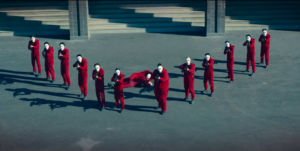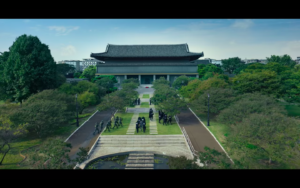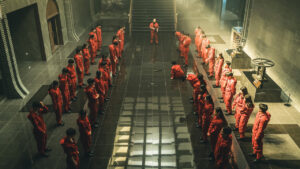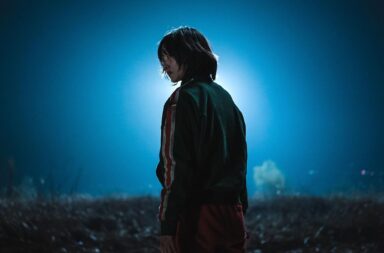
Ah, the remake. A tricky thing to nail at the best of times, and a term with about as much stigma as “sequel” or “reboot” in our modern entertainment age. Get them right, and you can use the bones of a great story to say something new (like Scarface or A Star Is Born). Get them wrong, and you get someone’s homework sloppily copied out on smudged paper with some of the words spelt wrong (cough, American version of Oldboy, cough).
A lot of the reason for the stigma comes from the very clear motives behind so many of these recreations, made particularly clear when they are done badly. So often it feels like a lazy cash grab, redoing a thing that is definitely popular, and thus avoiding the risk of making something new that might not be. People liked that thing? Do it again with younger actors, throw in a different subplot, and it’s a done deal!
But what about when something significant to the original plot is shifted dramatically? That is the backdrop to Netflix’s latest marketing push, Money Heist: Joint Economic Area. This show is a remake of the Spanish mega-hit La Casa de Papel, a show so impactful that Netflix has made a documentary about its success. This version of Money Heist transposes a team of robbers from a hostage situation in the Spanish Royal Mint, to one in the Mint of a joint economic zone created between North and South Korea.
Imagining a near future where the war has ended and free movement is allowed between nations, and unification is the next step written on the cards. This is undoubtedly a situation worlds apart from Spain and unique to Korean history and culture, suggesting that the motives behind this particular remake may be less cynical and more intellectual in nature.
And in some respects, they are. The show is peppered with the beginnings or hints of interesting ideas and dynamics. However, Money Heist: Joint Economic Area ultimately fails to set up a distinct purpose on its own terms, relying too heavily on the structure, narrative, and characterisation of its forebear to be engaging in and of itself. There is a huge amount of potential in the ideas and the talent used, but frustratingly much of it is underserved and suffers in comparison to the original.
Now, of course, it is unfair to base any critique of a piece of art entirely on something outside it, ignoring its own merits. La Casa and Joint Economic Area are two separate shows, and it would not be entirely justified to only offer a comparison between Ryu Yong-jae’s version and Álex Pina’s. However, context is important, not least through the timing of the Korean show. It comes less than a year after the fifth season of the Spanish version, which, it’s again worth emphasising, was a huge hit. Considering Netflix’s current financial situation, one can sense some impatience to get the latest big title out there, with a story people already like, from a new up-and-coming world player, with some big names to display.

The names in question are undoubtedly a huge draw to Joint Economic Area. If one were to list the biggest hits from Korea in modern times, Squid Game, Parasite, Burning, and Oldboy would unfailingly appear. From these shows, we have Park Hae-soo as Berlin, Park Myung-hoon as the Mint Director, Jeon Jong-seo as Tokyo, and Yoo Ji-tae as the Professor. Sun from Lost (Kim Yun-jin) even appears as the head negotiator for the South Korean task force. Again, we can see a clear ambition to get the best group of actors together in order to promote this show as effectively as possible.
However, there is a limitation that stifles these actors: a six-episode run as opposed to twelve in the Spanish version. With half the running time given to this show than its predecessor, there is simply less room for characterisation and development of the story. It is not that the show does not try. Jeon Jong-seo as Tokyo gets a largely effective opening sequence to the series contextualising both her own upbringing in and leaving of North Korea, and the wider world of an almost-unified Korean peninsula. Berlin’s background in a North Korean prison gives us one of the most poignant moments in the season. Unfortunately, these sequences are not enough.
Once our band of red boiler-suited robbers is together and has broken into the Mint, the opportunities to see our characters grow three-dimensionally deteriorates. It is a curious move on the part of either Netflix or the writer, whoever it was, to push the running time to six episodes, because we simply miss so many moments to get to know these people, with some characters falling far more into the background than necessary.

Tokyo herself, aside from narrating the story, seems muted, almost a side character, while others like Nairobi (Jang Yoon-ju) are almost neglected. Both actresses give great performances—Jeong is so naturally expressive with just her face that she is able to convey a lot with a little, and Jang strikes the right mercurial balance for Nairobi’s energy—but we simply do not see them put to good use.
The same is sadly true for the rest of the cast, and by extension, leads to plot inconsistencies that undermine the impact that this story could have. For example, whilst Park Hae-soo is clearly having a lot of fun as the psychopathic Berlin (it is as if Sang-woo from Squid Game got into crime to solve his debts instead), there isn’t enough time to build to his more sadistic acts. Whilst his charm slowly chips away in the Spanish version, here it feels like a more sudden drop.
Details surrounding the hostage situation also become frustratingly fudged. In this particular hybrid genre of hostage and heist, clever details are key. However, in this condensed story, many simply become underwhelming. For instance, the Professor (Yoon Ji-tae)’s machinations to get himself involved with the investigation’s chief negotiator, Seon Won-jin (Kim Yun-jin) happen before the narrative begins in the Korean version, rather than playing out during, as they do in La Casa. It is a chance at delicately building up the stakes and tension that is just not taken in Joint Economic Area, and there are many other moments like it that make this version far more inert.

That is not to say that all of these plot deviations do not work, or are lacking in creativity. Some, such as the cutting of the unrequited love subplot within the investigation team, are not missed here. The additional of distinctly Korean politics to the backstory of characters like Tokyo also add an enthralling layer that certainly functions independently from those in La Casa.
In fact, the show’s greatest moments come in its cultural move away from the original, which takes the form of the alternate world of cooperation between North and South Korea. Just as an idea, it is inherently intriguing, and the show’s writers cleverly use it to create internal tensions within the various groups in the drama. Rather than a united front, the hostages and the investigation team are beset by tensions between the two cultures.
There are insults thrown at the behaviours of the different citizens, political machinations plague the police from both sides, and Berlin even exacerbates these differences to sow suspicion among the hostages. The best plot points come from moments derived from these ideas, such as Tokyo’s backstory, or the blundered interception attempt by the North Korean police team under the nose of their Southern colleagues. These are the points where the writing is allowed to be the most creative, and exciting, and it is a shame that the show does not push further in this direction.

Ultimately, the show does indeed stick too closely to the storyline of the Spanish version to gain its own credibility. This exciting political setting eventually becomes the backdrop to the same story that so many people have seen before, and the distinctly Korean elements—these North-South tensions, or the Hahoe masks instead of the Dali ones—become exciting side notes rather than central storylines.
Of course, being the star-studded Netflix production that it is, there was never really any doubt that this show would be visually high-quality. There are ample examples of beautifully framed wide shots, emphasising the scale of the group’s operation and the grandeur of the place they are infiltrating. Shots peering down over hostages, staircases, or the Mint itself give a sense of play with positions: we are looking down on something that has such a high status. The colour saturation is also well-balanced, with the red of the boiler suits and the stark monochrome of the masks standing out well against the drab greys and browns of the mint. Visually, the creativity with perspective and hierarchy is there.
But, once again, there is the question of how much was borrowed from the original story, and how much has been added by this version. With actors like Jeong, Park, and Yoo in the arsenal, it seems all the more underwhelming that the story and structure have not allowed them to stray from hitting most of the same beats as the Spanish version.

This is why Money Heist: Joint Economic Area ultimately fails as its own piece. With not enough time to flesh any narrative out, and not enough bravery to fully commit to making a different story, this becomes another addition to the failed remake category. Review-bombed on IMDB, seemingly for this exact reason, hopefully a second series can take more chances to be more distinctly Korean, rather than a copy that is chomping at the bit to be more.
(Youtube. Images via Netflix)


